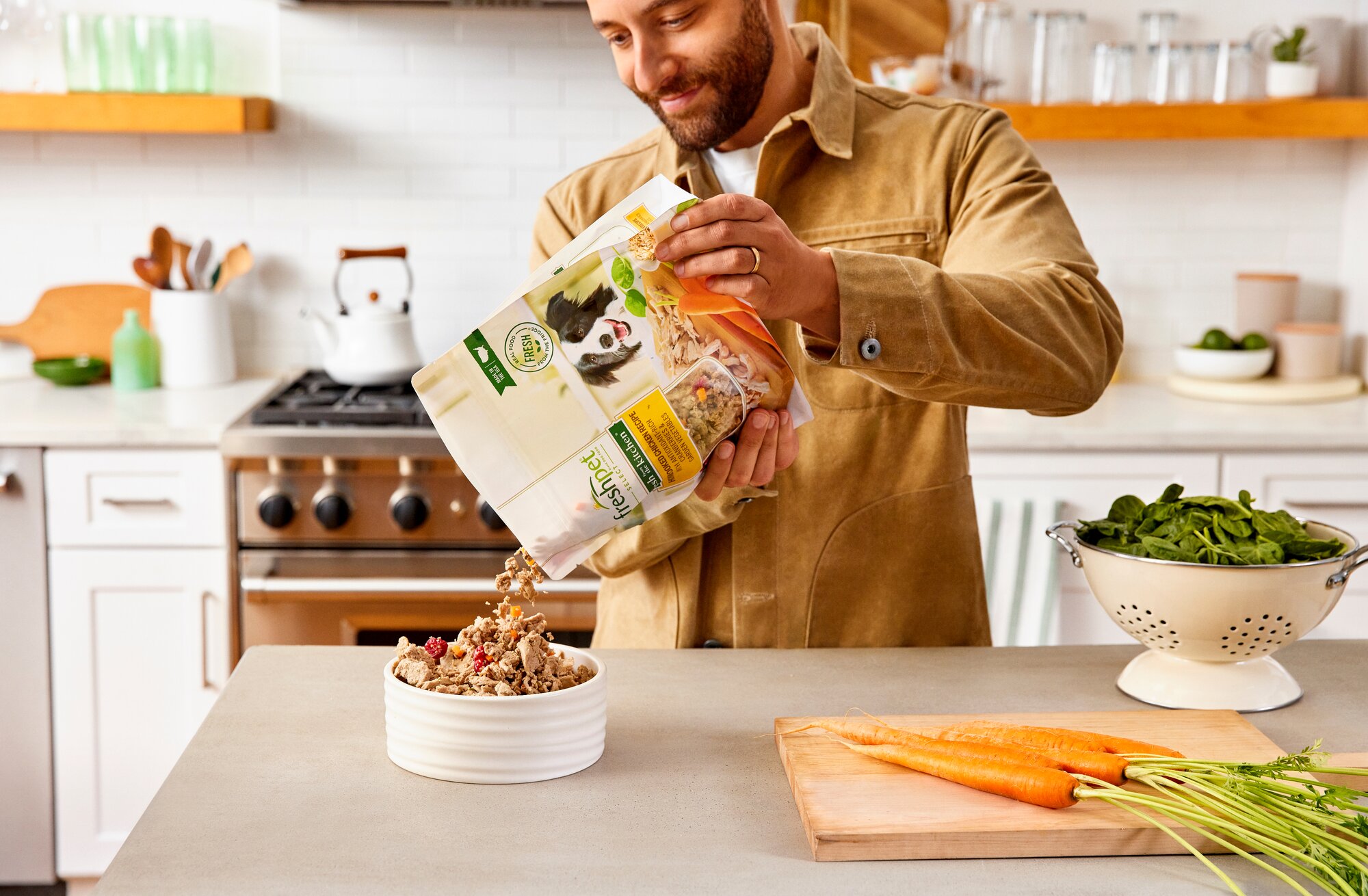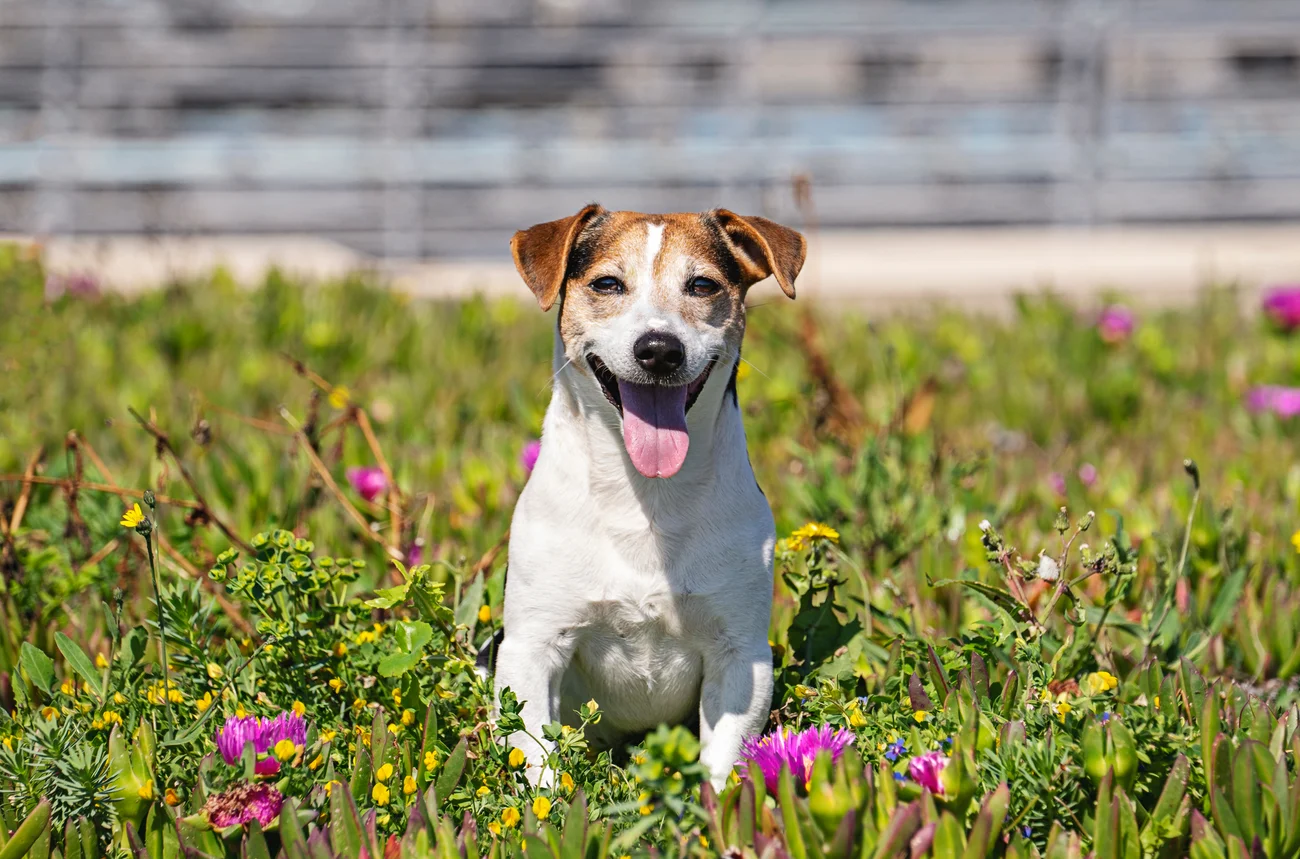
Five Ways Freshpet Can Help Dogs With Weight Management
written by Freshpet Vet Team
Weight problems in dogs are often straightforward:
overfeeding leads to weight gain, especially if the dog lacks activity to burn off extra calories. If your clients are looking to help manage their dog’s weight, here are five ways fresh dog food can help:
Higher Moisture Content
Freshpet’s gentle steam-cooking process helps retain each recipe’s moisture, which is then passed on to the dog. Freshpet recipes often have a moisture content varying from 58 to 78 percent, more than six to eight times the moisture you’d find in dry kibble. Well-hydrated pets tend to be less hungry1, according to Dr. Leni Kaplan, senior lecturer at Cornell’s Richard P. Riney Canine Health Center..
Along with increased satiety, the higher moisture content in fresh food means dogs need a larger portion compared to dry food to meet their energy needs. Why is this important? Some researchers (Coe et al., 2019) investigated the amount of food provided to the dog when using different measuring cups2-3.. This is known to be a very common practice by pet parents: feeding by volume versus by weight of food. The researchers found that when feeding smaller volumes of food, the overestimation could be up to 70%. However, when feeding higher volumes of food, the overestimation decreased to approximately 10%. Thus, the need to feed higher volumes of fresh food (as compared to dry foods) might help pet parents to measure an animal’s daily meals more accurately.
Volume of Food Can Be Deceiving
As you’ve likely come across in your practice, pet parents often feed the bowl, not the dog. “Pet parents feed their dogs by the feeling that there is enough food in the bowl, rather than measuring the right amount of food,” says Renan Antunes Donadelli, PhD, R&D Project Development Scientist at Freshpet. This could lead to overfeeding If they feed dry food which has very little to no water—they might feed greater portions than they should and more often, he says.
Dr. Donadelli explained that “it has been known since the late 80’s that the volume of food in the stomach is the first stimulus to satiety. In that study5, it didn’t matter if the researchers filled the dog’s stomach with water, water with nutrients, or air, the response was based on how much the stomach was distended, not what was in the stomach”. Thus, feeding a food high in moisture, like Freshpet, might contribute to start the satiety response. As you’re talking to your clients about the differences they’ll notice when feeding Freshpet, they should be aware that the bowl can appear to have more food than when they feed dry. Also, when they pick the bowl up, it likely feels heavier than a bowl of kibble. “Pet parents might think they are feeding their dogs more food when, in reality, they are feeding the right amount of calories—or closer to the right amount—as compared to dry foods,” says Dr. Donadelli.
Less Calorically Dense
Dry pet food is the most calorically dense product available. At over 300kcal /100 kg on average, dry kibble is good for pets that need a lot of energy (calories) in a small amount of food. However, this is often the exception with most pets. When managing to a pet’s ideal weight, dry pet food can offer more calories in the bowl than the pet needs to maintain a healthy weight. Primarily due to fresh meats and a higher moisture content, our fresh meals average about half the calories by weight or 175 kcal/100 kg on average. Freshpet’s lower caloric density creates full bowls for pet parents, full stomachs for pets, but with less calories consumed.
Highly Digestible
Freshpet’s recipes are balanced meals. Each package is formulated by our scientific team to ensure it checks all the boxes when it comes to proteins, fats, vitamins, minerals, etc. In a 2019 collaborative study in the Journal of Animal Science4, university researchers looked at the chemical composition of the true nutrient digestibility scores of different types of chicken used to make different pet food types. Steamed chicken was found to have the highest digestibility values in the study, while chicken meal had the lowest. This evidence suggests that gentle cooking provides benefits even over raw chicken, due to greater amino acid bioavailability. Freshpet recipes are steam cooked, which kills pathogenic microorganisms while retaining the nutritional value and highly palatable textures and flavors.
Fresh food isn’t meant to sit out
Some of your clients might scoop kibble into their dog’s bowl to be eaten periodically throughout the day. While you know that isn’t ideal for a few reasons—food safety being a big factor—it also might make the pet more likely to overeat. They can graze because the food is there, not because they’re experiencing hunger signals. Some research found that “free access” to a high-fat diet led to dogs having higher weight gain and more body fat6.
Freshpet’s “fresh-from-the-fridge meals” can’t sit out for long—and there’s a good chance the dog won’t let it anyway. This means pet parents are more likely to portion out the food in meals for their pets, which helps to control how much the dog is eating, says Dr. Donadelli. This can help with a dog’s weight management.
Keep in mind that while Freshpet is not a therapeutic diet, you can browse for a pet’s ideal recipe based on a specific dietary need such as lower calories or fat. This tool allows you to make more tailored suggestions to your Freshpet clients if weight management is a concern.
One last bit of advice when counseling clients. Freshpet meals are highly palatable. Your clients’ pets might eat it faster than other food and look at pet parents for more. This doesn’t necessarily mean they’re still hungry. The specially formulated fresh food should keep them full for hours, and more energetic.
They just want more of a good thing. Can you blame them?
References
1.Rinley, R.P. https://www.vet.cornell.edu/departments-centers-and-institutes/riney-canine-health-center/canine-health-information/obesity-and-weight-management-tips
2.Coe, J.B., Rankovic, A., Edwards, T.R., Parr, J.M. 2019. Dog owner’s accuracy measuring different volumes of dry dog food using three different measuring devices. Veterinary Record, 185(19): 599-605. DOI: 10.1136/ vetrec-2018-105319
3.Murphy, M., Lusby, A.L., Bartges, J.W., Kirk, C.A. 2011. Size of food bowl and scoop affects amount of food owners feed their dogs. Journal of Animal Physiology and Animal Nutrition, 96:237-241. DOI: 10.1111/j.1439-0396.2011.01144.x
4.Oba, P.M., Utterback, P.L., Parsons, C.M., de Godoy, M.R.C., Swanson, K.S. 2019. Chemical composition, true nutrient digestibility, and true metabolizable energy of chicken-based ingredients differing by processing method using the precision-fed cecectomized rooster assay. Journal of Animal Science, 97:998-1009. DOI: 10.1093/jas/sky461
5.Pappas, T.N., Melendez, R.L., Debas, H.T. 1989. Gastric distention is a physiologic satiety signal in the dog. Digestive Diseases and Sciences, 34(10):1489-1493. DOI: 10.1007/bf01537098
6.Beynen, A. 2017. Fat content in dog food. Creature Companion, 40-41. DOI: 10.13140/RG.2.2.17708.05765





